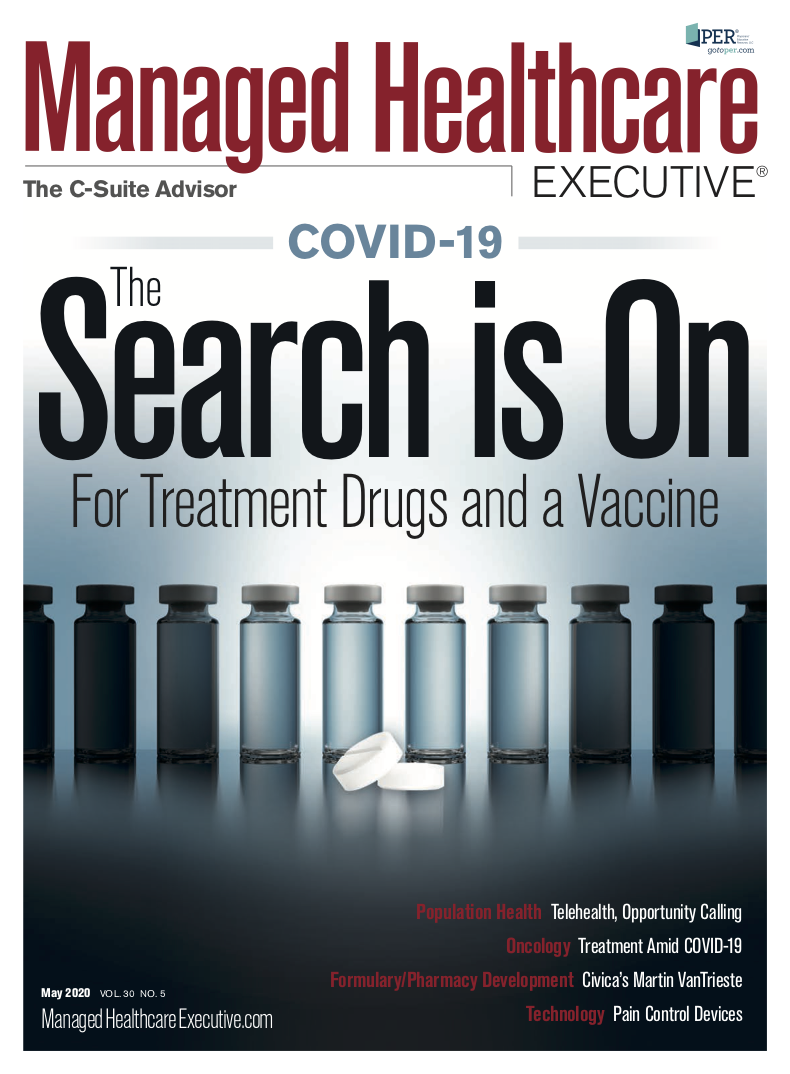Opportunity Calling. Will COVID-19 Bring Telehealth Into the Mainstream of American Healthcare?
If American healthcare does wind up getting divided into pre- and post-COVID-19 eras, the migration from in-person visits to telehealth ones will likely be one of the biggest developments on the right-hand side of the inflection.

It took American Family Care, an urgent care and primary care company headquartered in Birmingham, Alabama, just 36 hours to roll out its telemedicine service, AFC TeleCare, after the COVID-19 outbreak struck. “We had been thinking about it and deciding when we wanted to venture into it (telemedicine)” prior to the pandemic, says Benjamin Barlow, M.D., the company’s chief medical officer (CMO). “We met on a Monday, and the next day it was a go.” Since AFC TeleCare’s launch in March, many of the calls the company has received involve medication management for established patients, Barlow says.
If American healthcare does wind up getting divided into pre- and post-COVID-19 eras, the migration from in-person visits to telehealth ones will likely be one of the biggest developments on the right-hand side of the inflection. Population health experts and advocates have been eyeing telehealth for some time as a way to monitor patients, encourage healthy behaviors and increase adherence to medications.
“It’s recognized as an effective and often more efficient means to connect with patients to provide healthcare and chronic disease management,” says Mitchell Kaminski, M.D., MBA, a family physician and program director of population health at Jefferson College of Population in Philadelphia. The COVID-19 outbreak moved thought, research and pilot projects into full-on implementation mode.
“We’ve gone from incremental change in 10 years to very rapid, transformative change” because of COVID-19, Kaminski says, as virtual care gives providers the opportunity to offer much needed care during the pandemic while keeping patients safe by not making them come in person and wait in a doctor’s office.
As a family physician and leader in population health, Kaminski says he had long thought that he should provide virtual care for his own patients, but it languished on the to-do list. He envisioned a steep learning curve. And like many physicians, especially those who deliver primary care, he assumed that telehealth visits couldn’t measure up to the in-person ones in establishing a strong doctor-
patient relationship.
Related: FCC Approves Sixth Set Of COVID-19 Telehealth Program Applications
But he has been pleasantly surprised. “I have been amazed at the connection I feel, even with patients I’ve never met before,” says Kaminski, who has been seeing patients remotely through JeffConnect, an app set up by the Thomas Jefferson University Hospitals system, as well as having telehealth visits with his own patients.
Pre-COVID-19
Before the COVID-19 outbreak, telehealth had been edging its way into American healthcare delivery. The convenience of being able to receive immediate care online via a mobile device has undeniable appeal for patients, especially compared with having to wait days, even weeks, to be seen. In many cases, the virtual visits had a lower copay. In some cases, the services were provided by hospital and healthcare systems. In others, they were the reason to be for so-called direct-to-consumer companies such as Teladoc Health and were offered as an add-on benefit to employer-based health insurance.
A 2019 J.D. Power survey found about 10% of respondents had used telemedicine in the previous 12 months. Two years ago, Michael Barnett, M.D., an assistant professor at the Harvard T.H. Chan School of Public Health, and his colleagues reported the results of a study of telehealth usage in an unnamed health plan in JAMA. (Although the plan is not named, the de-identified claims that Barnett and his co-authors used came from OptumLabs.)
From 2005 to 2017, those health plan members made almost 385,000 virtual visits, and usage climbed from 0.02 visits per 1,000 members in 2005 to 6.57 visits per 1,000 members in 2017. More than half the visits were for mental healthcare, and almost 40% were for primary care. Barnett’s report shows a steep increase in telehealth use starting in 2015.
Teladoc, which stakes a claim to being the country’s most experienced and largest telehealth provider, reported that its number of virtual visits reached 4.1 million in 2019, a 57% increase over the previous year. On March 13 of this year the company reported that virtual visits had increased by 50% in the previous seven days compared with the week before. Teladoc provided about 100,000 virtual visits during that time. Its stock price shot up from $128 per share on March 13 to $167 on March 23.
Maven Clinic, a digital health startup that focuses on women’s health, saw a 500% spike in virtual mental healthcare mid-March when pandemic hit the United States, says CEO Katherine Ryder. Virtual care is “dramatically reshaping” healthcare delivery, she says. [After that initial spike, Maven subsequently saw a 300% increase in virtual mental health visits over the past two and a half months, a company representative said at the end of May.]
Kaminski says that Jefferson emergency department physicians set up the JeffConnect app about three years ago. Patients were charged a relatively small copay. “They were providing about 50 telemedicine visits per day until the pandemic hit, and suddenly they found themselves dealing with over 3,000 visits a day, a 60-fold increase.”
Reimbursement matters
“The slow adoption of telemedicine tools really has been reflective of the lack of payment or limited payment for visits,” notes Kaminski. Prior to COVID-19, CMS had been slowly relaxing restrictions on the telehealth services that Medicare would pay for. For example, starting this year, Medicare Advantage plans were allowed to offer telehealth as a basic benefit. Last year, Medicare started paying for brief virtual check-ins with patients with whom a physician has an established relationship. But in March, CMS swept away many restrictions and agreed to pay for telehealth visits at the same rate as in-person visits. Rules that had required in-person visits with nursing home residents and hospice and end-stage renal disease patients have been waived.
For commercial payers, a 2019 report by the law firm Foley & Lardner LLP found only 10 states had payment parity laws requiring equal reimbursement for virtual visits and in-person care. But amid the COVID-19 outbreak, some states have ordered private insurers to reimburse providers for telehealth services at rates no lower than what they pay for in-person care. Some insurers have waived cost sharing for telehealth visits, and a few - Aetna, most prominently - are matching the CMS policy of paying for telehealth visits at the same rate as in-person visits.
Prior to the reimbursement changes, “it just wasn’t worth it” to have American Family Care doctors offer telemedicine services, says Barlow, the CMO. “You lost money.” But that has changed now that some insurers “are recognizing the value and need for this and are paying us for it,” he adds.
No going back
CMS could relax its telehealth rules because COVID-19 was declared a public health emergency. Once that the emergency is over, legally, the rules will go back into effect. There’s also a chance that the current appetite for telehealth is particular to the COVID-19 outbreak and to the social distancing designed to mitigate its worst effects. Kaminski says a large percentage of his telehealth visits have been about easing people’s COVID-19 fears. Still, he doesn’t see a return to the pre-COVID-19 era of telehealth when it was largely on the margins of American healthcare.
“I think of it as opening Pandora’s box. We see all the benefits of this technology patients are experiencing: greater access and convenience for care. And we’re finding that it’s effective for their care.
“When the pandemic is over,” Kaminski continued, “I don’t think anyone can predict what is going to happen. But it’s hard to imagine that we can put Pandora back into the box and say, ‘Let’s go back to this less efficient, more costly, fee-for-service-based, RVU (relative value unit) system that we
had before.’”
There is a question, though, about who will be providing telehealth. Part of the appeal of the direct-to-consumer providers is that they make their service available around the clock. Many traditional, office-based providers will presumably add telehealth visits as a service, but it is hard to imagine their having 24/7 coverage.
Another question centers on what exactly post-COVID-19 telehealth will be used for. Amid the outbreak, it helps people stay home. But what happens afterward? Population health experts like Kaminski worry about weakening the already tenuous continuity of American healthcare if people depend too heavily on the direct-to-consumer providers. Kaminski is also concerned about loss of data.
“When a patient has a visit with a nonaffiliated service or provider, whether it’s at a drugstore or through a virtual telemedicine visit, does that information get back to that patient’s primary medical record? It will matter if it affects the medications they take for their illnesses. So where there’s concern about the continuity with providers, you also have to think about continuity of data,” he says.
The digital divide between low- and middle-income Americans and the affluent may be a fault line in the future of telehealth. Enthusiasts for online endeavors of all kinds sometimes gloss over the fact that reliable, high-speed internet access is not available to everyone for economic, geographic and
other reasons.
Some observers also see a generational split. Baby boomers may still be attached to the in-person visit, partly because they are aging and will therefore tend to have more complex medical problems. In a webinar in March sponsored by Brookings Institution and the Leonard D. Schaeffer Center for Health Policy & Economics at the University of Southern California, Deutsche Bank analyst George Hill said he expects demand for telehealth care to continue, particularly among younger patients, who are “provider agnostic.” Instead, in this convenience-driven society, they want “a doctor serving you on your terms, when you’re ready,” he said.
Susan Ladika is a health and business writer in Tampa, Florida.

In the Scope of Virtual Health and the Future of “Website” Manner, Per Ateev Mehrotra
August 10th 2023Briana Contreras, an editor of Managed Healthcare Executive, had the pleasure of catching up with MHE Editorial Advisory Board Member, Ateev Mehrotra, MD, MPH, who is a professor of healthcare policy at Harvard Medical School and an Associate Professor of Medicine and Hospitalist at Beth Israel Deaconess Medical Center.
Listen